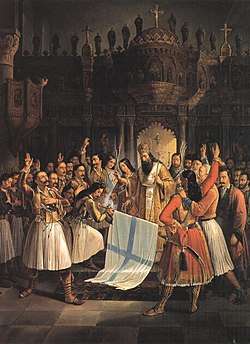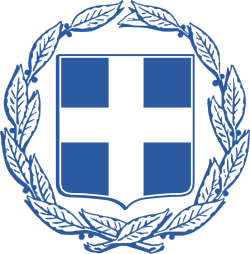National colours of Greece
The national colours of Greece are blue and white.

Blue and white are also the national colours of Israel, Argentina,[1] El Salvador,[2] Guatemala,[3] Honduras,[4] and Nicaragua,[5] were the former national colours of Portugal,[6] and are the colours of the United Nations.[7]
History

Blue and white appear to have been historically used by Greeks for several centuries, and were used during revolts against the Ottomans prior to the 1821 revolution [8]. In March 1821, the Greek War of Independence broke out, an effort by the Greeks to free themselves from the Ottoman rule by declaring independence. The struggle to secure independence would continue until 1832.[9] Later in the year, deputies from various provinces of Greece assembled at Piada (near Epidaurus, and today known as Nea Epidauros) in the First National Assembly to draft the first Greek Constitution, which was published on 1 January 1822.[10] The Constitution of 1822 was the first of many which would lead to the modern Constitution.[11]
In addition to the constitution, the delegates selected Athens as the new national capital, though it had yet to be conquered from the Ottoman Empire.[12] They also selected a new standard for the troops, a "white cross on an azure field",[12] a new naval flag, and new national colours, sky blue and white;[13][14][15] the new colours replaced those used by Alexander Ypsilantis, and the black used by the Filiki Eteria,[12][16] and were specified in the Constitution.[13] The flag was raised at the Acrocorinth after its capture on 26 June 1822.[15]
In the Greco-Italian War, during which Italian forces occupied parts of Greece in 1940 and 1941, Greek civilians in Póthia would taunt the occupying forces by painting their houses in blue and white.[17] Some houses still retain this colouration among the more typical pink and ochre buildings.[17]
Symbols and decorations

The coat of arms of Greece consists of a white cross on a blue escutcheon which is surrounded by two laurel branches.[18] Although the tincture for the branches is designated as "proper",[19] which implies the colour found in nature,[20] it is usually displayed with blue laurel branches; the president, military, and security services use golden branches instead. The Flag of Greece is also blue and white, as defined by Law 851/1978 Regarding the National Flag.[21] It specifies the colour of "cyan" (Greek: κυανό, kyano), meaning "blue", so the shade of blue is ambiguous.
The Order of the Redeemer and military decoration Cross of Valour both have ribbons in the national colours.[22]
Sport
An official report from the 1896 Summer Olympics stated that pigeons adorned with ribbons in the national colours were released from Panathenaic Stadium after Spyridon Louis, winner of the marathon, was introduced to accept his medal and a trophy.[23]
Notes
- Smith: Flag of ArgentinaDerived from the colours and flag of the Federal Republic of Central America.
- Smith: Flag of El SalvadorDerived from the colours and flag of the Federal Republic of Central America.
- Smith: Flag of GuatemalaDerived from the colours and flag of the Federal Republic of Central America.
- Smith: Flag of HondurasDerived from the colours and flag of the Federal Republic of Central America.
- Smith: Flag of NicaraguaDerived from the colours and flag of the Federal Republic of Central America.
- Teixeira 1991.
- United Nations Visitors Centre 2012.
- Skartsis 2017 Origin and Evolution of the Greek Flag
- Finlay 1836, p. 17–18.
- Keightley 1830, p. 1–2.
- Hellenic Parliament.
- Keightley 1830, p. 3.
- Murray 1823, p. 93.
- Cargill 1841, p. 75.
- Cochrane 1837, p. 359.
- Parish 2007, p. 381.
- Chilton, Dubin & Ellingham 2004, p. 353.
- Εφημερίς της Κυβερνήσεως 1975, p. Article 2.
- Εφημερίς της Κυβερνήσεως 1975.
- Edmondson 1780, p. 161.
- Law 851/1978, p. Article 1, Clause 1.
- Presidency of the Hellenic Republic: The Order of the Redeemer.
- Lampros & Polites 1896, p. 234"When the herald called out the name of Louis, and when the victor in the Marathon Race ascended the platform, the Stadion resounded with cheers which seemed to take no end. Pigeons adorned, with ribbons of the national colours of Greece, were let flying across the Stadion; national flags and handkerchiefs were agitated in the air; nobody can even attempt to describe the joy, the enthusiasm of the Greek people; the foreign guests were not a little astonished by it."
References
- "ΣΗΜΑΙΑ" [Flag] (PDF). Archived from the original (PDF) on 20 January 2013. Retrieved 24 March 2013.
- Skartsis, Labros S. (2017). Origin and Evolution of the Greek Flag. Athens: (Open Access eBook). ISBN 978-960-571-242-6. Retrieved 21 June 2017.CS1 maint: ref=harv (link)
- Cargill, William (1841). The foreign affairs of Great Britain. John Reid and Co.CS1 maint: ref=harv (link)
- Chilton, Lance; Dubin, Marc S.; Ellingham, Mark (2004). Rough Guide to the Greek Islands. Rough Guide (5 ed.). Rough Guides. ISBN 184353259X.CS1 maint: ref=harv (link)
- Cochrane, George (1837). Wanderings in Greece. 1. London: Henry Colburn.CS1 maint: ref=harv (link)
- Edmondson, Joseph (1780). A Complete Body of Heraldry. 1. T. Spilsbury.CS1 maint: ref=harv (link)
- Finlay, George (1836). The Hellenic Kingdom and the Greek Nation. London: John Murray.CS1 maint: ref=harv (link)
- Keightley, Thomas (1830). History of the War of Independence in Greece. 2. Edinburgh: Constable and Co.CS1 maint: ref=harv (link)
- Lampros, S.P.; Polites, N.G. (1896). The Olympic Games: BC 776 – AD 1896 (PDF). Translated by C. Anninos. Athens: Charles Beck. Retrieved 24 March 2013.CS1 maint: ref=harv (link)
- First National Assembly at Epidaurus (1823). The Provisional Constitution of Greece, translated from the second edition of Corinth, accompanied by the original Greek. Translated by John Murray. London.
- Parish, Henry Headley (2007). Neuhaus, Manfred (ed.). Exzerpte und Notizen, September 1853 bis Januar 1855. Karl Marx / Friedrich Engels Gesamtausgabe. 4. Akademie Verlag. ISBN 9783050034881.CS1 maint: ref=harv (link)
- Smith, Whitney. "Argentina, flag of". Hispanic Heritage in the Americas. Encyclopædia Britannica. Retrieved 28 March 2013.
- Smith, Whitney. "Guatemala, flag of". Hispanic Heritage in the Americas. Encyclopædia Britannica. Retrieved 28 March 2013.
- Smith, Whitney. "Honduras, flag of". Hispanic Heritage in the Americas. Encyclopædia Britannica. Retrieved 28 March 2013.
- Smith, Whitney. "Nicaragua, flag of". Hispanic Heritage in the Americas. Encyclopædia Britannica. Retrieved 28 March 2013.
- Smith, Whitney. "El Salvador, flag of". Hispanic Heritage in the Americas. Encyclopædia Britannica. Retrieved 28 March 2013.
- Teixeira, Nuno Severiano (1991). Bethencourt, Francisco; Ramada Curto, Diogo (eds.). Do azul-branco ao verde-rubro: a simbólica da bandeira nacional. A Memória da Nação (in Portuguese). Gabinete de Estudos de Simbologia. Sá da Costa. ISBN 9725622936. Retrieved 28 March 2013.CS1 maint: ref=harv (link)
- "Νομος ΥΜ' ΑΡΙΘ 48" [Law YM' Number 48]. Εφημερίς της Κυβερνήσεως της Ελλενικης Δημοκρατιας (Official Gazette of the Hellenic Republic) (in Greek). Εθνικό Τυπογραφείο. 108 (A). 7 June 1975. Retrieved 26 March 2013.
- "Constitutional History". The Parliament : The Political System. Hellenic Parliament. Retrieved 26 March 2012.
- "The Order of the Redeemer". Presidency of the Hellenic Republic. Archived from the original on 15 February 2011. Retrieved 26 March 2013.
- "Fact Sheet: United Nations Emblem and Flag". United Nations Visitors Centre. 21 December 2012. Retrieved 28 March 2013.
